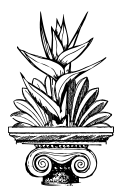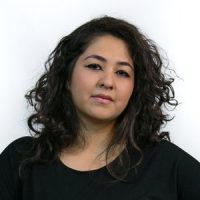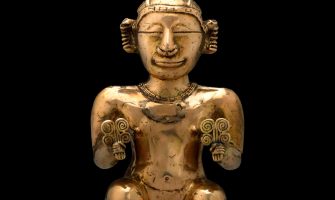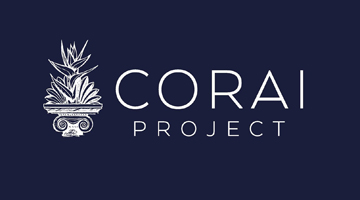CAA News Today
An Interview with Andrea Iaroc, Founder and Executive Director of the CORAI Project
posted Jan 18, 2018
Andrea Iaroc created the CORAI Project to help art historians, in particular those without the privileges to access professional networks and generous financial resources. For more than ten years, her passion for historical research, teaching, writing, and philanthropy have advanced her work in museums and other art institutions, and forwarded her understanding of non-profits and intentional community work. An iconographer at heart, her current independent research interests focus on cultural hybridity and identity art.
Joelle Te Paske, CAA media and content manager, spoke with Andrea to learn more about the work CORAI is doing, her thoughts on CAA, and fundraising for inclusive art history.
This interview has been edited for length and clarity.
Andrea Iaroc: I’ve been a member of CAA since 2007. I see the way the organization has moved in the past years—it’s definitely a different direction.
Joelle Te Paske: Most definitely. That’s part of the reason why I’m here, too.
AI: It used to be a little bit more traditional. That’s one of the things I’m focused on—moving art history away from that traditional foundation, [which is] very ivory tower. It’s exclusive and I wanted to change that in founding the CORAI Project.
It was frustrating as a woman of color—but, I admit that I do have privilege. I don’t have college debt, but I saw friends in school sometimes struggle with simple things, such as professors asking us to go to a gallery, or buy a membership to CAA for instance. The question was always: “Okay, do I use this money to pay for my books for this class, or do I …?” It was this thought in the back of my head, and those things happen because art history has been a “girls with the pearls” academic field. We still have that image problem.
JTP: Yes. That’s the stereotype.
AI: When you’re trying to do fundraising for art history, a lot of people ask: “What exactly are you doing, are you going to save the world?” It’s not a practical STEM field, but we need to equalize it in reflection of current sociocultural changes. We need to amplify the voices that have not been heard because of European ethnocentrism and patriarchy. The way that we experience the world, the way we grow up, our background—all inform the way we interpret things. That is important for me.
In August 2016, I finally managed to realize the idea of creating something new [the CORAI Project]—getting a logo, a mission, values, and building up a board. We’re just over a year old. CORAI stands for Creating Opportunities for Representing Art History Inclusively. Our logo features a heliconia plant, a South American Heliconia Bihai (even though I was born in Brooklyn, NY my parents are Colombian). The foundation of the logo is very Greco-Roman, but the heliconia is breaking through that ionic capital, moving up and breaking through. Our logo is pretty much what we want to do.

From the CORAI website: The Greek Ionic order is studied in every art history 101 class. It is part of classic architecture and, to this day, is used in governmental and certain religious buildings. It very much represents the Western roots of the field, as well as the palm that opens up on the background. Both Romans and Greeks were fond of foliage to adorn their capitals. In the middle, however, is a South American heliconia shooting upwards – transcending the heavy and old marble foundation. Design by Bella Hall.
JTP: I love that.
AI: Yes, it’s time to break through and do different things. [CORAI Project] gives away springboard grants, small grants to give a little ‘push’, to art historians who identify as PoC, people of color, in the state of Washington. So far, our first grantee back in the spring of 2017 used her money to go to the Rubin Museum of Art so that she could use their collections to complete her thesis.
JTP: That’s terrific.
AI: She was studying thangka paintings of Tibet [Tibetan painting using ground mineral pigment on cotton or silk]. She was the only person in the University of Washington, Seattle, doing this which therefore will change the records of art history in the university because she’s only one of two students this year that are graduating with a focus on Chinese art history.
The person that received the grant in fall 2017 is going to invest it in Japanese translation to ensure her thesis is correct. Although she’s faced resistance to her art historical Japanese art focus, she’s following through. One of the things that happens is that professors who do not have experience in what they call “non-western” arts, question PoC’s methodologies, settings, and interpretations because a traditional art history is the only thing they know. You need to do what you want to do.
That’s what this is about, and it’s small. But we’re out there and hopefully we can inspire other art history organizations to break the mold.
JTP: That is wonderful work. What would you say is the most exciting part for you personally?
AI: The moment the grants are given away. I see their motivation and enthusiasm for what they want to do in school or independently to shake things up in art history. That’s the best part.
JTP: Yes, you see the changes they’re putting in place.
AI: Exactly, because it gives results. It’s something solid. If the only thing I do in this life is to change one person’s take on art history, which is also my career, then so be it. So far we’ve helped a couple of them.
JTP: I’m with you. It’s definitely slow, but it’s exciting to see those changes happen.
I’m curious, have you heard about the recent Ford Foundation and Walton Foundation initiative?
AI: Yes, I read about it.
JTP: What do you think about it?
AI: I thought that CAA made an interesting question [on Facebook] at the end, like, “Do you think it’s a little too late?”
JTP: That was me [laughs]. Six million dollars is a lot of money, but spread over 20 organizations over three years…
AI: Exactly. That’s one of the things that I struggle with—I mean we’re a community organization—and I have been told by several people, “Oh, just talk to so-and-so, they’ll give you the money.” But the problem is, they’re very powerful and they want to jump on the bandwagon of “diversity and inclusion” and so their name is going to be attached to this project, but do they really mean it? What have they done that maybe goes against the integrity of who I am and what my organization is? This is the case when big organizations move the right way, but what does that mean? For instance, does that mean that they’re going to get Walmart to diversify?
JTP: Or let their workers unionize?
AI: Right, exactly.
JTP: A friend of mine online made the point of: we’re looking at how to get women and people of color and LGBTQ folks into leadership positions—we’re not talking internships.
AI: It’s good that people are a little bit more critical about these things because to [the Walton family] six million, it’s really nothing. What is this really about?
JTP: Yes, and I think it can be both good and bad. But asking the question is really important.
AI: Exactly.

Andrea Iaroc. Courtesy CORAI Project.
JTP: Have you attended CAA conferences in the past? What did you think?
AI: Yes. In 2012 I attended the 100th conference in Los Angeles. It was a big deal.
Back then, I was just coming out of five years of research for my thesis on Jewish art, specifically iconography. I looked for a relevant session and when I went, the organizer said it had taken them 16 years to get CAA to have a session on Jewish art. That it took them 16 years was disappointing, but there we were.
There were talks already of having another Jewish session in 2013 and now I can see that things have changed. The way that the conferences look now five years later is different.
Back then I went to a Pre-Columbian session where you had all these folks who, yes, of course, are excellent at their research profession and uphold conservation and believe in the return of a lot of these items to their countries. But at the same time I felt, “Really, you couldn’t find one Latin American professor that could talk about this? Just one?” You have all these folks that are white American and Canadian and they’re telling you about your heritage—it feels really strange.
When you look at [the conference sessions] now, the layout in terms of the list of people who are talking and where they come from and the sessions—it’s much better.
JTP: That’s good to know. I’ve been involved with the organization for less time than a lot of its members, including you, so I’m always curious to ask people. I think energy apart from the conference is also really important, making sure that people feel supported not just when they’re in one place together.
AI: Exactly.
JTP: Do you have suggestions for organizations besides CORAI that people should be following?
AI: There’s Art History That. It’s run by two women (Karen J. Leader and Amy K. Hamlin) and sometimes they post their own writings. They gave us our first Facebook shout out for our first grant. They’re very supportive about anything that’s changing in art history, the paradigms, the way that we even talk about women sometimes. In 2017 when you go to an Art History 101 class, women are still muses, but we’re not the artists. We’re still not taken into account as having a genius, especially when we’re talking about classics. The way that we talk—that language needs to be changed.
There’s also Smarthistory. They are from New York and they offer free resources for art history.
Material Collective, you may have heard of it because it’s connected to Art History Teaching Resources. They’re both connected and even have this big group of medievalists who are trying to fight the white supremacist narrative.

A piece featured in Smarthistory’s “South America before European colonization” section. Hands up close (detail), Seated Female Poporo, c. 500 B.C.E. – 700 C.E. Early Quimbaya, tumbaga (gold alloy), Colombia © The Trustees of the British Museum. Courtesy Smarthistory.
JTP: Excellent, thanks! What is the focus of your own research? You’ve mentioned it, but just to reiterate.
AI: Jewish art and iconography was my original focus, but because of it I’ve switched to cultural hybridity art.
JTP: Oh, interesting.
AI: Cultural hybridity includes artists who, because of the way our world has different heritages, draw inspiration from their mixed background. For instance, I had been researching contemporary Jewish artists and I ran across a work from Maya Escobar, who is from Missouri. Her dad is from Guatemala, he’s of Mayan ancestry, and her mom is Jewish, Ashkenazi, and so she made a tallit, a Jewish prayer shawl, using Mayan weaving techniques. That fusion of tradition—I’m very interested in it.
JTP: Do you think artists and art historians can change the world?
AI: Because I think that everything is connected, I always say art history does not exist in a vacuum.
JTP: I agree.
AI: Everything that’s happening scientifically, economically—it’s reflected. You’re going to see it in 50 years when you look back at art, you’re going to see it. Can it change the world? It can help change the world because humanities play a crucial role. The humanities help you see the world in a different way. They help your critical thinking skills and help you read humans. It helps you build community.



